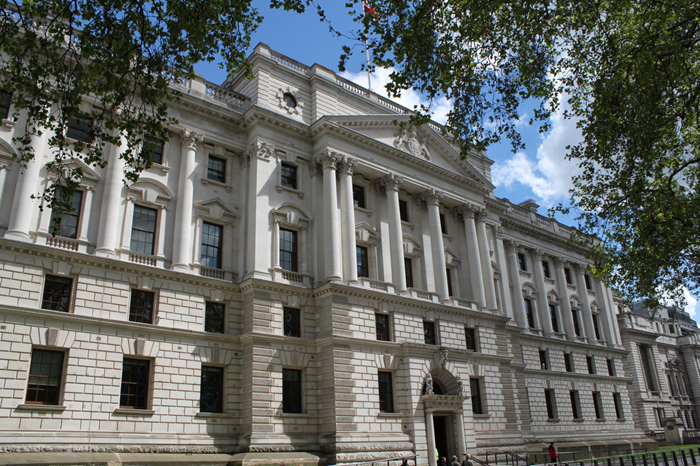Economic growth in the UK in the two decades prior to the pandemic averaged 1.8%,
almost a percentage point lower than over the previous two decades.1
Over the same period
before the pandemic, UK output per hour grew by 1% per year, fifth in the G7.2
As a result,
public services have been funded by increasing the tax burden to historic highs as a share of the
economy,3
weighing further on growth.
1.2 High inflation is compounding this problem by dragging on growth in the near term.
Putin’s invasion of Ukraine and weaponisation of Russian energy supplies has further
increased gas prices, putting upward pressure on inflation and interest rates, raising the
cost of government borrowing. High inflation is weighing on consumption and investment,
slowing growth.
1.3 The government has taken action in response to these challenges. In the short term, fiscal
policy will support households and businesses through the current period of high energy prices.
A comprehensive package of supply-side reform and tax cuts will contribute to the government’s
primary economic objective to boost trend growth to 2.5%.
Economic growth
1.4 Stronger growth is essential for improving living standards. Economic growth is primarily
driven by increasing the number of hours worked or by making people more productive while
in work. However, since the financial crisis, most G7 economies have seen a slowdown in
productivity growth.4
UK labour productivity growth slowed from roughly 2% in the decade
before 2008 to 0.4% in the decade after.5
Low productivity growth, coupled with pressure on
the public finances through the financial crisis and the COVID-19 pandemic, has contributed to
the highest debt burden since the 1960s at 96.6% of gross domestic product (GDP).6
1.5 Boosting productivity growth and labour supply is therefore central to raising the UK’s
economic growth. The supply-side reforms announced are at the centre of the government’s
Growth Plan and represent an ambitious first step towards achieving 2.5% trend growth in GDP.
The government is removing barriers to the flow of private capital – whether taxes or regulation,
supporting skilled employment, accelerating infrastructure delivery, getting the housing market
moving and cutting red tape for businesses (see Chapter 3).
1.6 After a faster than expected recovery in 2021, GDP growth has slowed during 2022
. On a
quarterly basis, the economy grew 0.8% in the first quarter of 2022 as COVID-related restrictions
were removed.7
GDP then fell by 0.1% in Q2, due to a steep fall in COVID-related health
activity and an additional bank holiday in June.8
Removing the effects of these one-off factors
1 Annual real GDP growth over the twenty years from 2000 to 2019 inclusive and 1980 to 1999 inclusive, Office for National Statistics, April 2022.
2 Annual growth in real GDP per hour worked over the twenty years from 2000 to 2019 inclusive for G7 economies, OECD database: Growth in GDP per
capita, productivity and ULC, accessed on 14 September 2022.
3 Economic and fiscal outlook – March 2022, Office for Budget Responsibility, March 2022.
4 International comparisons of UK productivity (ICP), final estimates: 2020, Office for National Statistics, January 2022.
5 Output per hour worked, UK: 1971 – 2021, Office for National Statistics, July 2022.
6 Public Sector Finances, UK: August 2022, Office for National Statistics, September 2022.
7 GDP quarterly national accounts, UK: January to March 2022, Office for National Statistics, June 2022.
8 GDP first quarterly estimate, UK: April to June 2022, Office for National Statistics, August 2022.
10 The Growth Plan 2022
shows that growth in the rest of the economy has slowed, as rapidly rising prices have reduced
consumer confidence and weighed on retail spending.9,10 Higher input costs, supply chain issues
and lower demand have also acted as a drag on business investment.11
Inflation
1.7 Record energy prices have driven inflation up globally. Consumer Prices Index (CPI) inflation
was at a near 40-year high of 9.9% in August.12 Price pressures have become more widespread
since March, with a broader range of items in the CPI basket of goods and services seeing
increases that exceed the headline 2% CPI inflation target.
1.8 UK energy prices are linked to global markets and have been the largest driver of UK
inflation over the last year. Supply of gas to Europe has reduced further since the spring, after
Putin’s weaponisation of gas supplies. Prices have increased in the global liquefied natural gas
market as Europe and Asia have competed to secure supplies in advance of the winter, driving
up UK prices too.13
1.9 High inflation is affecting consumers and businesses. Households are seeing real incomes
fall, while firms struggle with rising costs. With unemployment at a near 50-year low of 3.6%
in the three months to July, the relatively small pool of available labour has, along with near
record vacancies, helped push nominal total pay growth to 5.5%. Despite this, real regular pay
(excluding bonuses) fell by a record 3.9% in the three months to July, due to high inflation.14 For
businesses, higher energy costs and broader supply chain issues have acted as a drag on growth
in some industries, such as manufacturing and construction.
1.10 The Monetary Policy Committee of the Bank of England is responsible for controlling
inflation and has taken action by raising interest rates to 2.25% and will begin active sales of UK
government bonds to reduce the stock of purchased bonds by £80 billion over the next twelve
months. The independence of the Bank of England is vital and the government has reconfirmed
its commitment to the monetary policy remit. The government has full confidence in the Bank of
England to take action to get inflation back to target.


